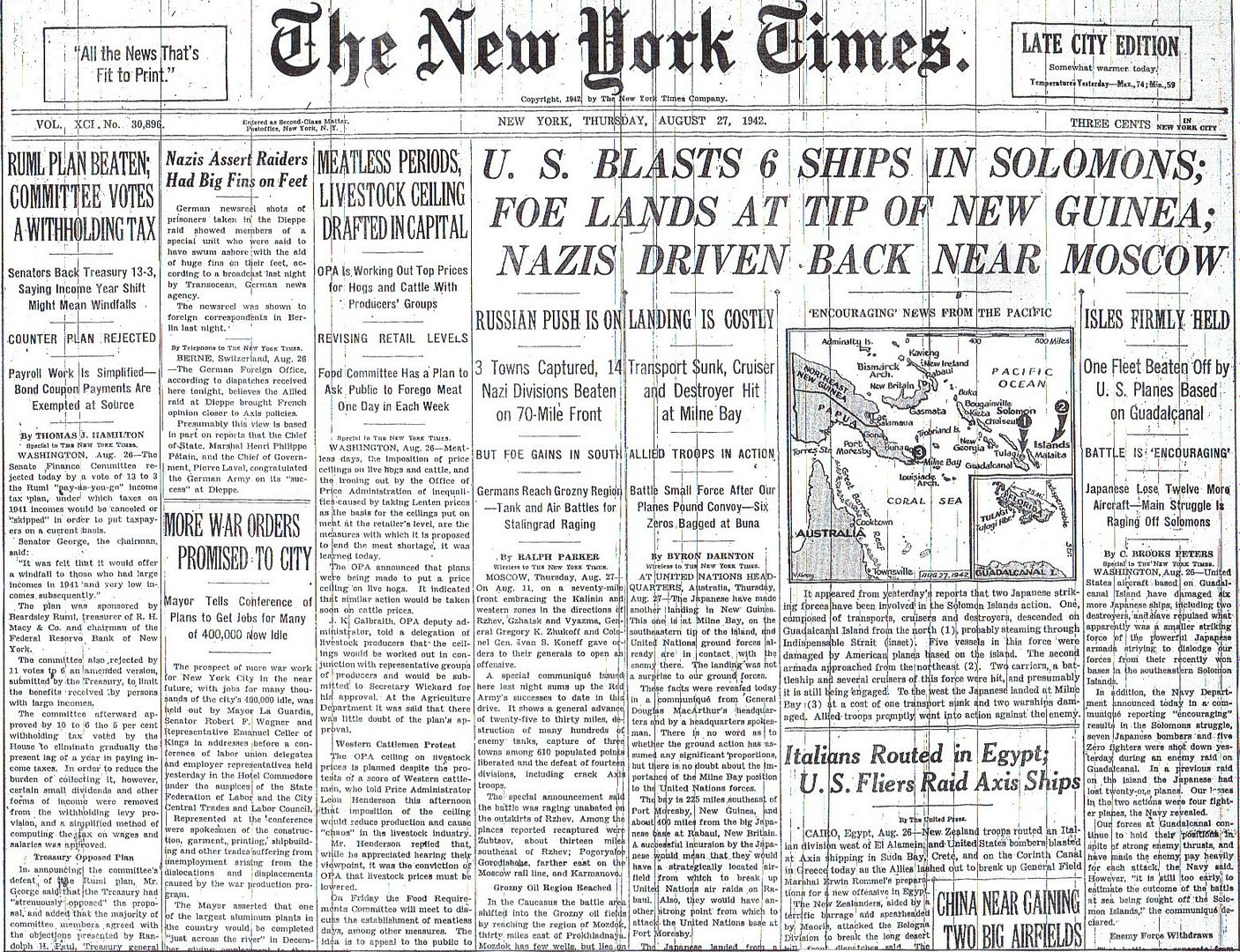
Posted on 08/27/2012 4:31:52 AM PDT by Homer_J_Simpson

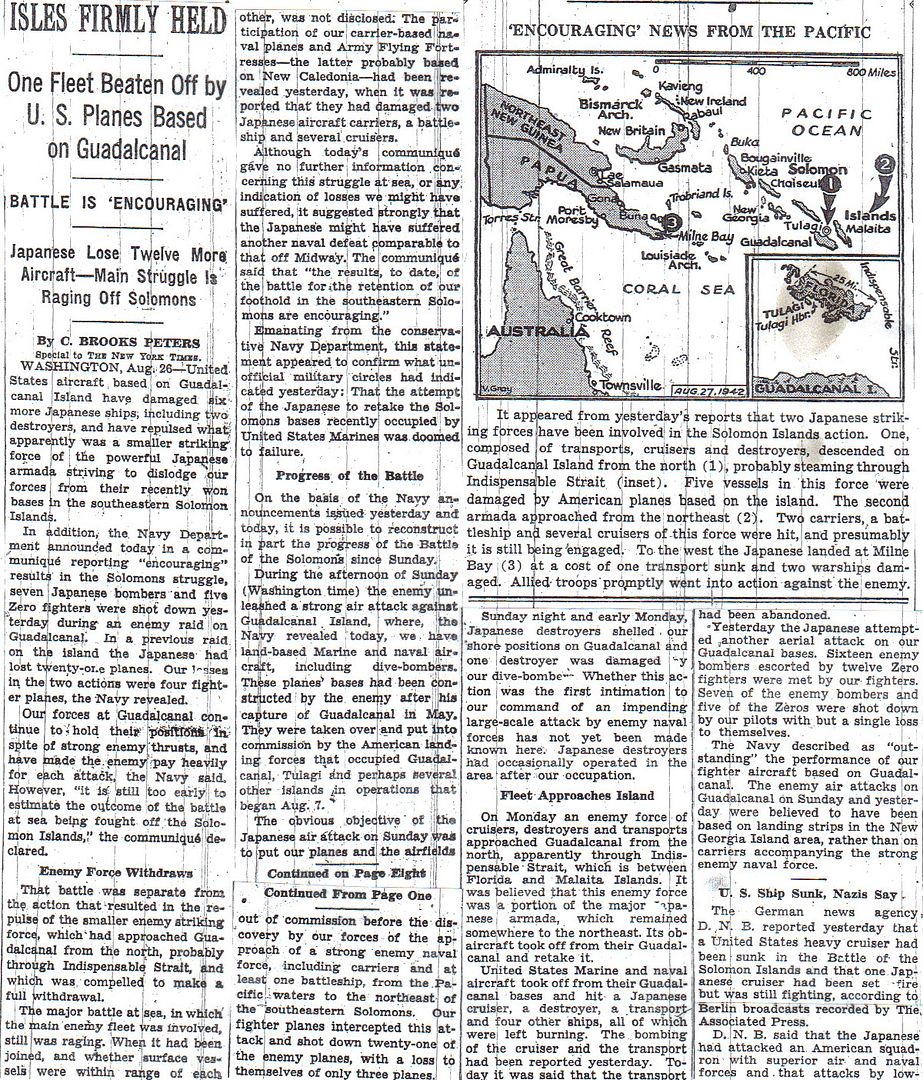

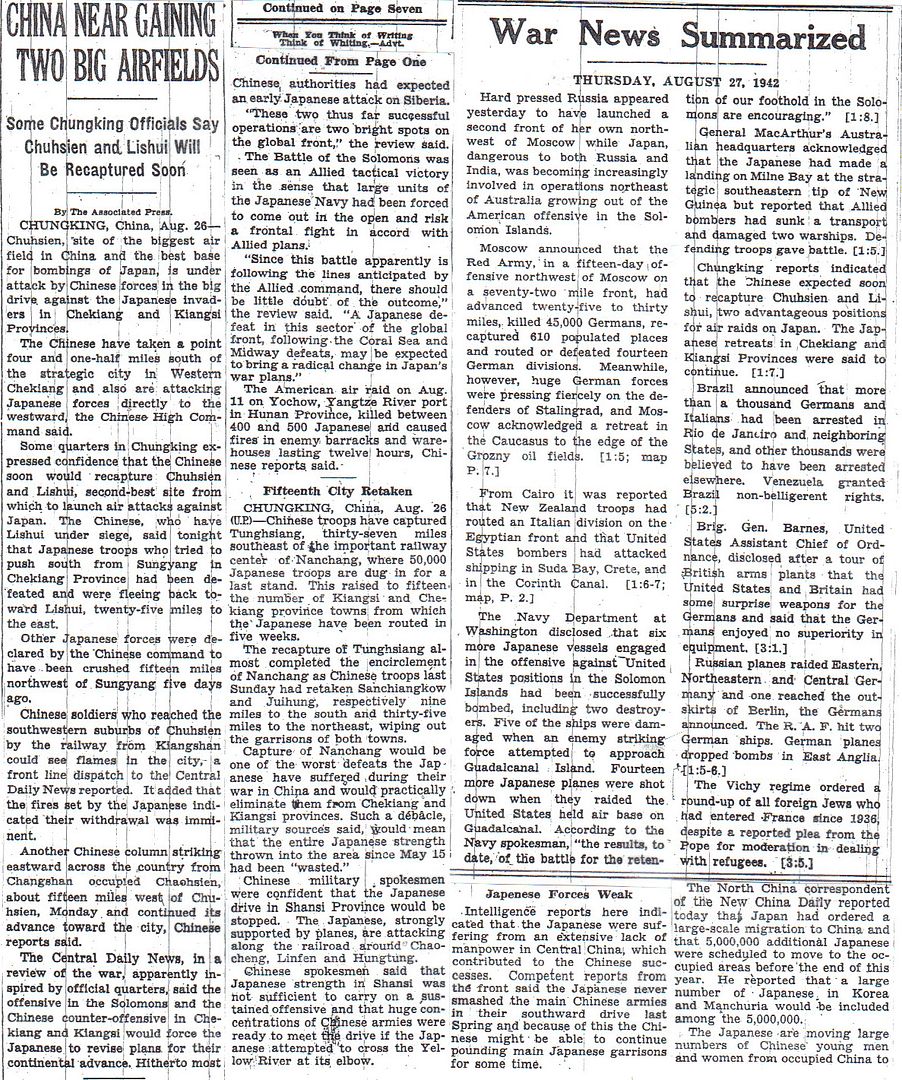
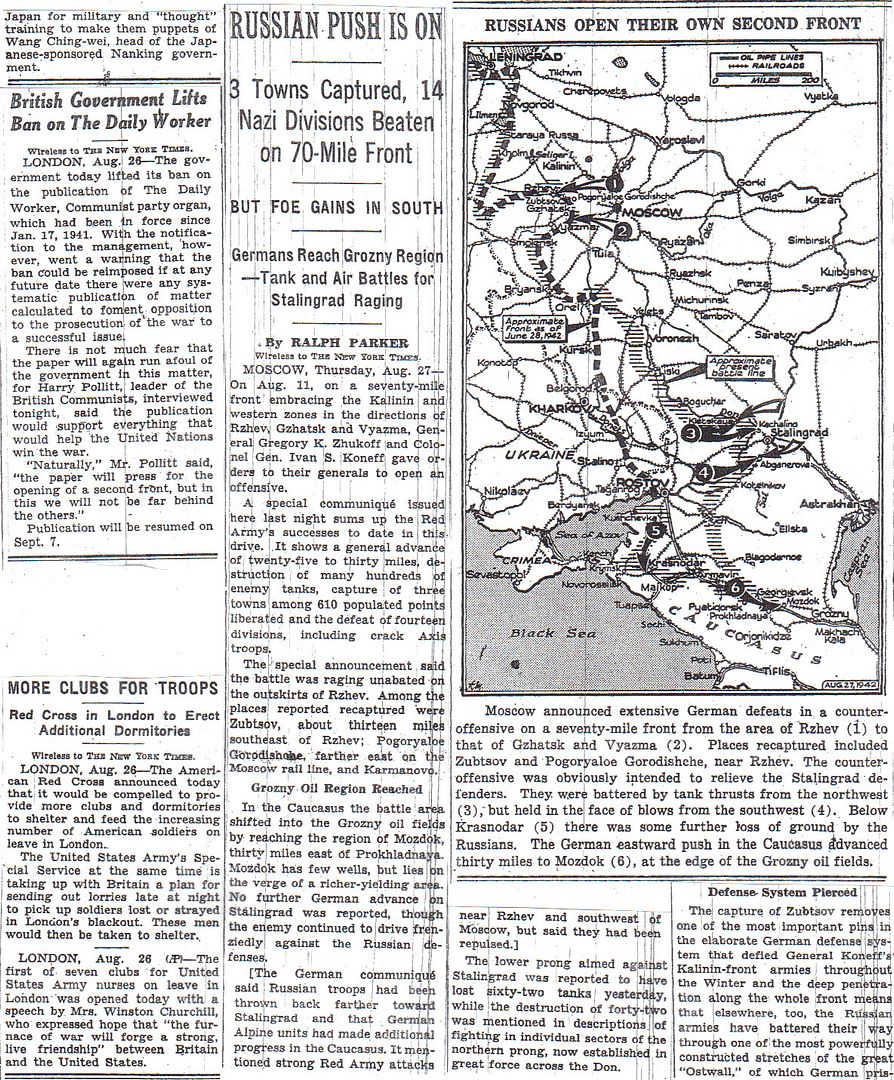


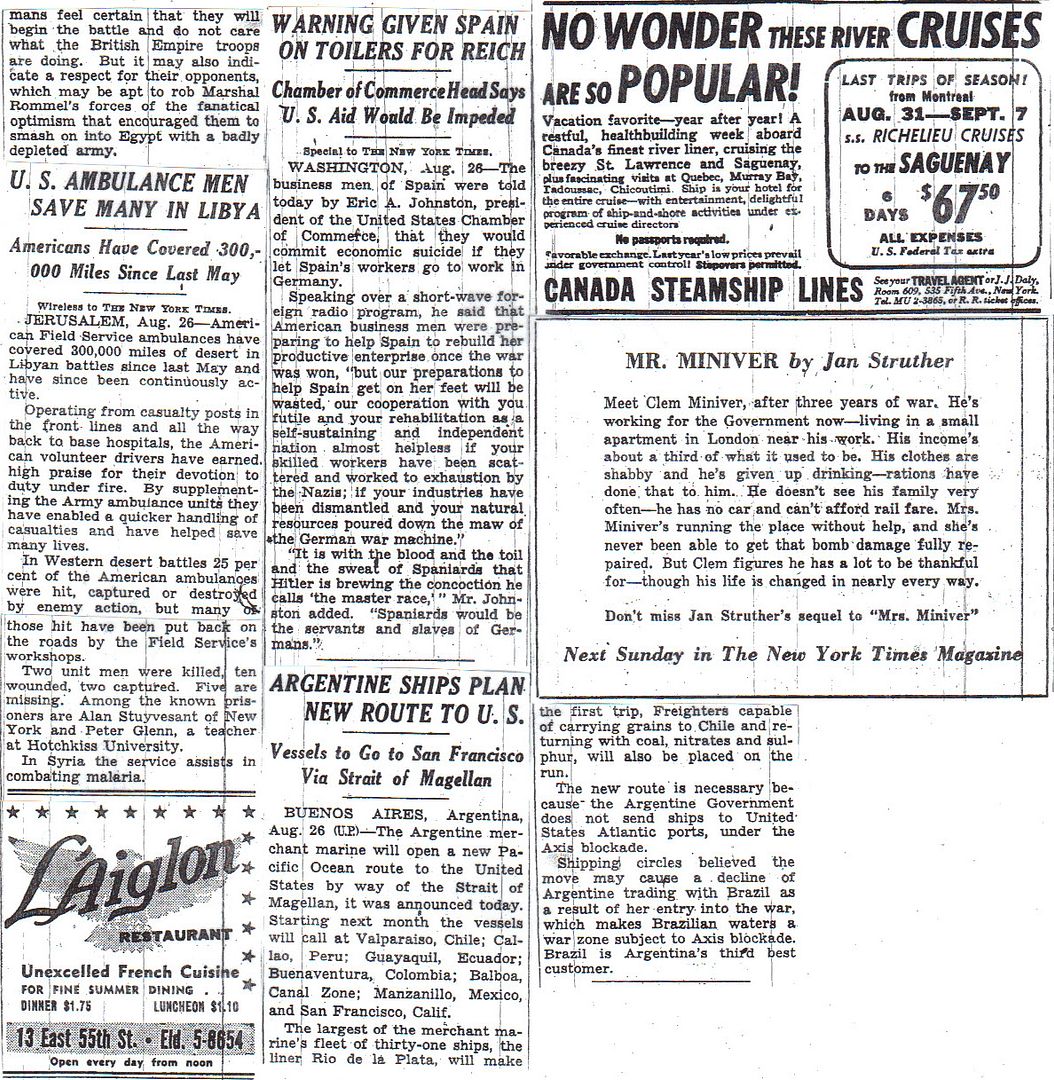
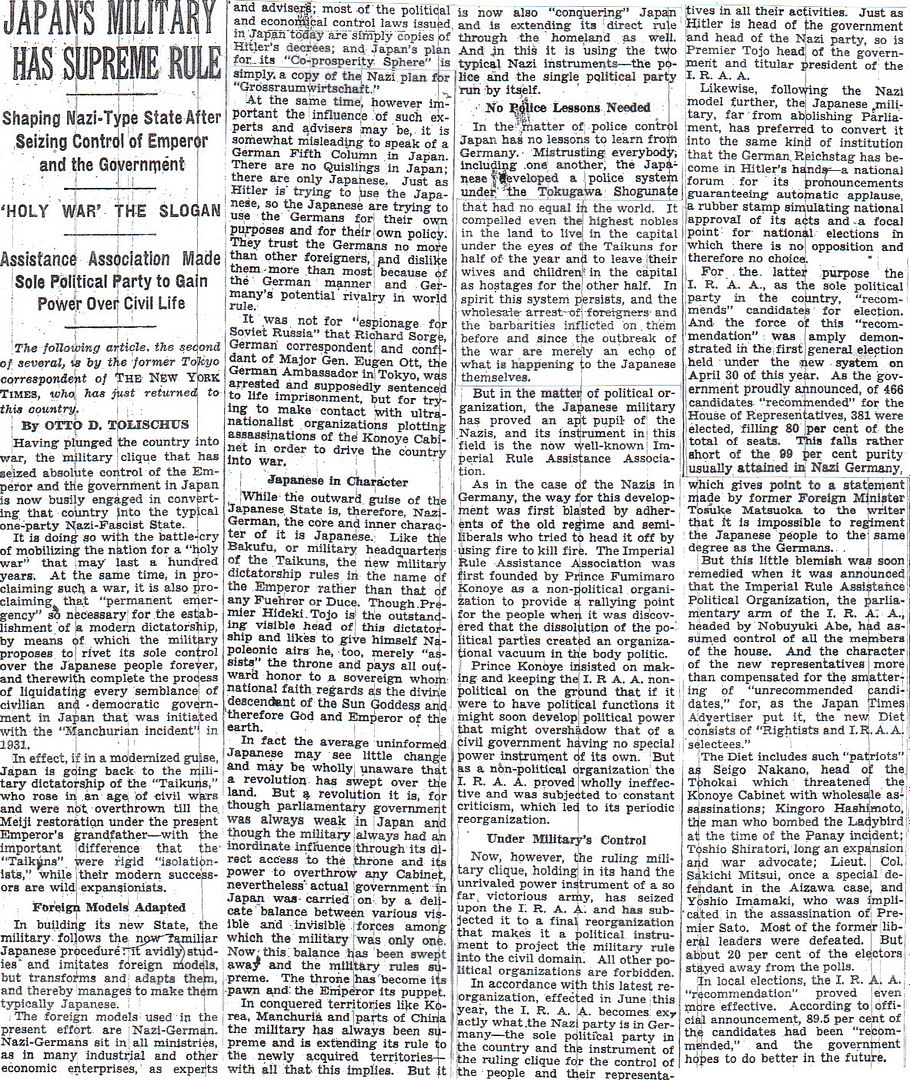



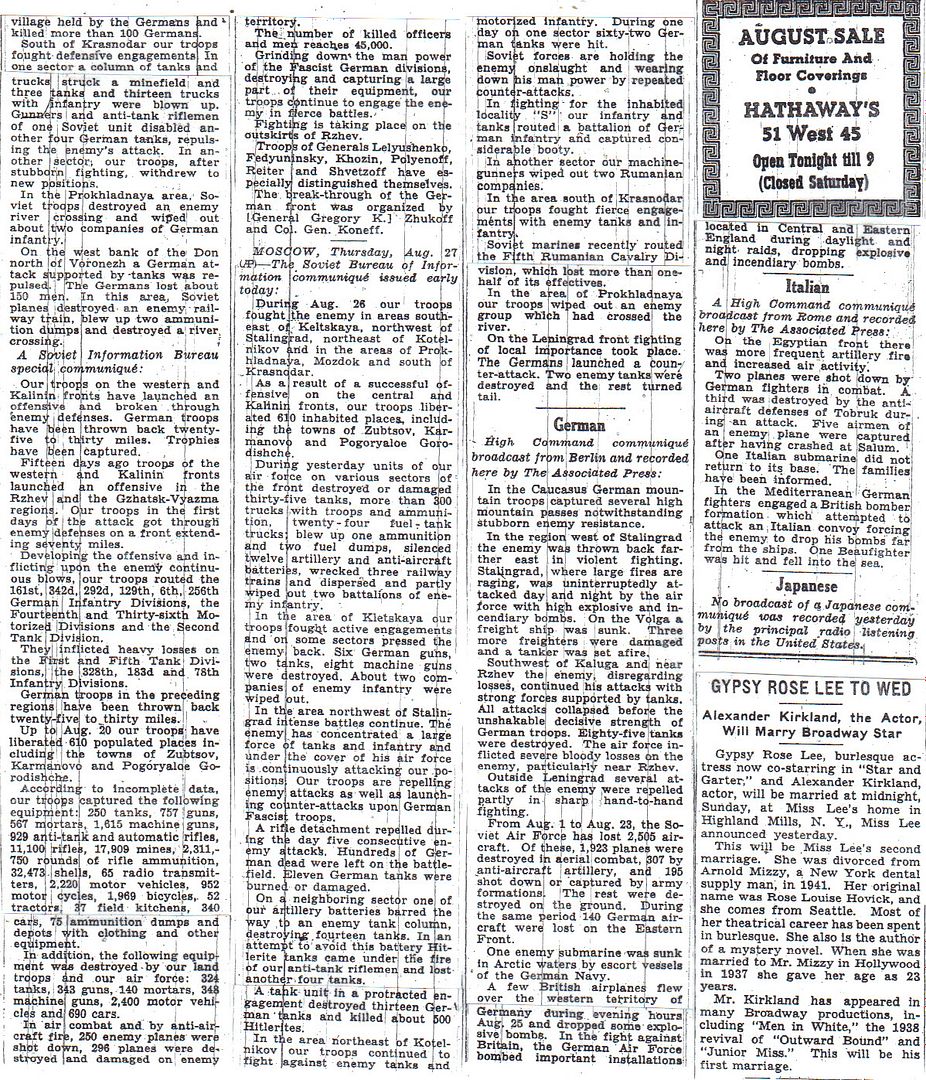
http://www.onwar.com/chrono/1942/aug42/f27aug42.htm
Fighting on the outskirts of Stalingrad
Thursday, August 27, 1942 www.onwar.com
German soldiers on the outskirts of Stalingrad [color photo at link]
On the Eastern Front... German attacks have reached Stalingrad on the Volga and the perimeter around the city is being reduced. In the far south, German forces cross the Terek River and capture Prochladrii
In the Solomon Islands... The Battle of the Eastern Solomons. Japanese submarine I-26 damages the USS Saratoga. It will remain out of action until October. The USS Wasp is now the only operational US carrier in the Pacific.
http://homepage.ntlworld.com/andrew.etherington/frame.htm
August 27th, 1942
UNITED KINGDOM: The US Eighth Air Force in England flies Mission 6: 7 B-17s bomb the shipyards at Rotterdam, the Netherlands at 1740 hours without loss. (Jack McKillop)
Aircraft carrier HMS Glory laid down.
Light cruisers HMS Black Prince and Spartan launched.
Frigate HMS Moyola launched. (Dave Shirlaw)
MEDITERRANEAN SEA: US Army Middle East Air Force B-24s bomb a convoy, hitting 1 merchant ship which is reported sinking. (Jack McKillop)
GERMANY: Rastenburg: Hitler orders the release of 800 French PoWs as a reward for the “exemplary conduct” of the people of Dieppe during the Allied raid.
U-637 commissioned. (Dave Shirlaw)
POLAND: Nine Lancasters of 106 Squadron, Bomber Command, were dispatched on a dangerous long-range raid against Gdynia in occupied Poland, where the German aircraft carrier Graf Zeppelin was being fitted out. The Lancasters were equipped with special Capital Ship bombs, designed to attack the target below the waterline. Seven of the Lancasters managed to find Gdynia after a 950-mile flight, but heavy haze prevented them from locating Graf Zeppelin, and they were forced to bomb targets of opportunity in the dockyard. All nine aircraft returned safely from an epic flight, notwithstanding the disappointing result. (Dave Shirlaw)
U.S.S.R.: Germany Army Group B continues the battle for Stalingrad.
Army Group A attacks southward into the Caucasus. 3rd Panzerdivision (GM Hermann Breith) bypasses Prokhladny on August 20, moved east along the north bank of the Terek River and captured Mozdok on August 25. (Jeff Chrisman)
In Siberia, the Kriegsmarine attacks the Arctic Russian town and port of Dikson, named after the Swedish Baron Oscar Dickson. The German pocket battleship Admiral Scheer, accompanied by two U-boats, destroys Dikson and a large icebreaker by shelling. The attack is part of Operation WUNDERLAND, aiming to stop Soviet convoys sent from Asian ports to support the Soviet Northern Fleet. Dikson was a strategic link on this route. No Soviet attempts to retaliate are known but as a result of WUNDERLAND the Soviet High Command orders an initiative to reinforce the Arctic coast. Therefore the NKVD, in charge of traffic and exploitation in Siberia, starts to plan a railway along the coast to make army operations possible in the area. (Jack McKillop)
NEW GUINEA: Six USAAF B-26s of 22 Bomb Group and P-400 Airacobras of the Allied Air Forces bomb Buna Airfield while P-40Es of No. 75 Squadron RAAF strafe the beachhead and fuel dumps at Milne Bay. The air battle was co-ordinated by Wing Commander Bill Garing RAAF, later to be closely involved in the Battle of the Bismarck Sea. The allied air attacks appear to have little effect, however, they also coincided with a Japanese air raid on the Allied positions and appear to have shot down one of the escorting Zekes - with at least two to go down to the Kittyhawks when they “jumped” them strafing the downed Zeke to destroy it. (Jack McKillop, Daniel Ross and Michael Mitchell)
The Australian 2/10th is led fighting the Japanese. Led by Col. Dobbs, the CO of 2/10 told his men not to drag the Boys guns with them because they were a very heavy weapon for an infantryman to carry through the bush. The Boys guns were anti-tank weapons that fired a 0.5 inch slug that would penetrate a light tank and shower the inside of the tank with metal splinters. 2/10 carried some “Stick Bombs” with them, and several men made heroic attempts to stick them to the sides of the Japanese tanks, but without success. (Jim Miller)
SOLOMON ISLANDS: The “Tokyo Express” lands 128 IJA troops northwest of Taivu Point on Guadalcanal. (Jack McKillop)
The rear echelon of the USAAF’s 67th Fighter Squadron, fourteen P-400 Airacobras, arrives at Henderson Field, Guadalcanal, from Espiritu Santo, New Hebrides Islands. (Jack McKillop)
TERRITORY OF ALASKA: ALEUTIAN ISLANDS: The US 11th Air Force sends 4 B-17 Flying Fortresses, 6 B-24 Liberators, and 2 P-38 Lightnings to fly weather, reconnaissance and patrol missions over Kiska and Atka Islands.
The Japanese begin to transfer the Attu Island garrison to Kiska Island, which is completed on 16 September.
CANADA: The Women’s Royal Canadian Naval Service is established. (Jack McKillop)
Minesweeper HMCS Truro commissioned.
The Battle of the St. Lawrence begins. U-517, OLtzS Paul Hartwig, CO sighted the five-ship Sydney to Greenland convoy SG-6F while it transited the Gulf of St. Lawrence escorted by the USCG A-class 165-foot cutters Algonquin and Mohawk. U-517 attacked SS Chatham, a 5,649-ton troopship carrying 562 passengers and crew, and hit her with two torpedoes. Although Chatham sank in an hour, only 13 lives were lost. The next morning, the Wickes-class destroyer USS Bernadou rescued 16 fully loaded lifeboats. She was assisted by HMCS Trail, a Flower-class corvette, Lt. George Stanley HALL, RCNR, CO. (Dave Shirlaw)
U.S.A.: The battleship USS Iowa (BB-61) is launched at the US Navy Yard, New York. (Jack McKillop)
Albert Monmouth Jones is promoted to major general (permanent). (Greg Kelley)
The motion picture “The Talk of the Town” is released today. This romantic comedy, directed by George Stevens, stars Cary Grant, Jean Arthur, Ronald Colman, Edgar Buchanan and Glenda Farrell; Lloyd Bridges has an uncredited bit part. The plot has a political activist (Grant) accused of arson and murder hiding out in the home of his childhood sweetheart (Arthur) who has just rented a room to an unsuspecting law professor (Colman). Grant and Arthur try to convince Colman that there’s a human side to the law. The film is nominated for seven Academy Awards including Best Picture. (Jack McKillop)
Submarine USS Dorado laid down.
Submarine USS Sickle launched. (Dave Shirlaw)
CUBA: The Cuban Navy and Air Force join the allied anti-submarine campaign. (Jack McKillop)
CARIBBEAN SEA: Corvette HMCS Oakville LCdr Clarence Aubrey King DSC, RCNR, CO, with Catalina a/c of VP-92 sank U-94 Kp/Lt Otto Ites CO, 17-40N 74-30W, West Indies. Sighted by the USN PBY which attacked with four 650lb depth charges and forced her to the surface, Oakville rammed and sank U-94, 2 officers including the CO, 9 senior and 15 junior ratings of 45 crew were rescued. LCdr Clarence Aubrey King a 56-year old veteran of WW I, during which he sank a U-boat while commanding a ‘Q’-ship. The action between Oakville and U-94 was extremely hot and was directed by two able and experienced commanders. U-94 was making a night approach from ahead on the northbound 29-ship tanker convoy TAW-15. The convoy had already lost two ships on the evening of 25 Aug to two other U-boats. Ites was making a surfaced approach with his hull awash and had just eluded HMCS Snowberry, when he was detected and attacked by the patrol a/c at 0257. His after diving planes were smashed and worse, the a/c had dropped marker flares. Oakville was soon on the scene and after a depth charge attack that was probably errant, sighted U-94 at a distance of about 600 yards. Ites skilfully manoeuvred his boat and Oakville managed only two glancing blows in her first attempts to ram, one of which opened a large gash that caused flooding into her own engine room. The third attempt was successful and the intervals between the collisions were filled with exchanges of gunfire, depth charges from projectors, and even soda bottles thrown from the bridge. King ordered a boarding party onto the U-boat by jumping from the forecastle. As they prepared to jump, the captain of the 4-inch mounting cleared a misfire by shooting just past the assembled group, which stunned all but two of the party. Undeterred, S/Lt Harold ‘Hal’ Ernest Thomas Lawrence and SPO Arthur James Powell jumped onto the U-boat and a short-range gun battle ensued that resulted in two Germans being shot. After the German crew exited the U-boat, Lawrence entered in search of codes or encryption devices but the boat was sinking and he had to swim to the ladder in order to clamber out. The majority of the survivors, German and Canadian, were subsequently recovered by destroyer USS Lea. Otto Ites was wounded three times during the action but survived the ordeal. Oakville was seriously damaged and had to detach for temporary repairs in Guantanamo Bay. She made her way to Halifax, by way of New York City, for an extended refit. She returned to service in Dec 43 and had an extremely active career for the rest of the war. The weakened escort for the convoy was unable to counter further attacks made by U-511, which resulted in three more ships being sunk. LCdr King went on to participate in the sinking of three more U-boats during his command of the frigate Swansea. He was given command of an Escort Group and reached the rank of Captain. For the sinking of U-94, Cdr King was awarded the DSO and the United States Legion of Merit, S/Lt Lawrence was awarded the DSC, and Powell was awards the DSM. Part b. (Dave Shirlaw)
GREENLAND: The German ship “Sachsen” anchors in Hansa Bay, Sabine Island, Northeast Greenland, and a landing party sets up a weather station, code name “Holzauge.” (Jack McKillop)
ATLANTIC OCEAN: U-517 sank SS Chatham with two torpedoes in Sydney-Greenland Convoy SG-6F of 5 ships escorted by USCG Algonquin and Mohawk. The 5,649-ton Chatham was a troopship carrying 562 passengers and crew and sank within an hour. 13 lives were lost.
German U-Boat sinks two ships off Newfoundland.
U-156 sank SS Clan MacWhirter in Convoy SL-119.
U-511 damaged SS Esso Aruba in Convoy TAW-15.
U-511 sank SS Rotterdam and SS San Favian in Convoy TAW-15.
U-516 damaged SS Port Jackson. (Dave Shirlaw)
Sounds promising. We'll send Crowther for a report.
Otto Ites was a young and successful submarine commander. He had sunk over 100,000 tons of allied shipping and had received the Knight’s Cross of the Iron Cross from Hitler. He was 24, and on the night of August 27, 1942 his career was to come to an abrupt though not fatal end.
Hal Lawrence was a Sub-Lieutenant on the Royal Canadian Navy’s corvette HMCS Oakville, escorting convoy TAW-15. He had already served for three years in the North Atlantic before being assigned to warmer waters. Tankers of the convoy were carrying fuel from Trinidad to New York, on the first leg of their perilous voyage to Europe.On that same night, Lawrence was to earn the Distinguished Service Cross. He was 22.
From “A Bloody War - One Man’s Memories of the Canadian Navy 1939-45”
by Hal Lawrence
“Fire a depth-charge pattern when we cross the spot where those depth-bombs landed,” rapped the Captain.
Lieutenant-Commander Clarence King had won a Distinguished Service Cross in the First World War for sinking one U-boat and getting two “probables”. His score in this war was zero and he didn’t like it.
He was quivering but his voice was controlled. Oakville trembled under the thrust of her screw at full speed. I pressed the fire-bell; out arched depth-charges, one either side from the throwers; three splashed off the stern. We tensed. Because of our relatively slow speed these things could damage us as well. With a rumble they exploded. Water erupted to mast-head height. Oakville bucked, shuddered, and resumed her eager trembling. Poor old girl; there was worse to come.
Before the reverberations died out there came a low drumming note in our earphones. The low drumming sound changed to the clamour of fast engines and the unmistakable turbulence of a submarine blowing her ballast tanks. She was surfacing.
A black snout reared out of the water. The conning tower burst through a swell and she surfaced completely. Water cascaded from her decks, white and foamy in the moonlight.
The captain altered course to ram. Two rockets, the submarine-sighted signal, hissed skyward and burst into white stars.
We had only about 300 feet to maneuver in. The captain couldn’t make it and we missed. U-94 bumped down the port side. The captain opened the range to get another run-in. This gave the gunners a chance.
Our four-inch gun roared out again and again. Two splashes we saw and then a satisfying orange flash on the submarine’s conning tower. The Oerlikon [20 mm] gun banged away, the red tracer flowing out and ricocheting at wild angles off the pressure-hull of U-94. Our bow swung on again.
Now the .5 inch machine guns started their insane chatter. The port gunner, ignoring the captain’s ear just six inches from the muzzle, let go the first burst. Have you ever seen a standing side-jump of twelve feet? Captain King did one that night. Olympic standard, I thought, and him fiftyish too.
We bore in. The 4-inch flashed again and U-94’s 88mm gun rocked over. Four streams of lead spewed from the .5’s, and down below I could hear the Lewis gun spitting. With precision and speed the German gunners poured out and made for their weapons. In that murderous fire none made it.
Ites was maneuvering U-94 with skill and by now at good speed. We hit with only a glancing blow; again U-94 passed down the port side, this time about twenty feet off. Now we unleashed a weapon hitherto untried in modern warfare.
Stationed on the fiddley abaft the funnel were six stokers not needed in the engine room during action. Their job was to reload the depth-charge throwers. But we weren’t firing the throwers so these stokers had nothing to do. And yet here were German faces on the bridge of a U-boat just a few feet away. U-94 was so close our guns could not depress to fire. Also on the fiddley abaft the funnel, the canteen manager stowed his empty Coke bottles. To stokers, ignorant engineers uninstructed in the art of war, the connection was obvious.
Imagine, if you can, six stokers pelting the enemy with Coke bottles at twenty feet, crying, “Yah! Yah!” Ducking heads on U-94 testified to their accuracy. If Ites’ courage ever forsook him, it must have been then.
Depth charges were fired again. One exploded directly under her. She bucked, spray obscured her, then she slowed. Oakville opened the range. If destroyers are ‘greyhounds of the fleet’, corvettes are the tenacious terriers. We opened range, swung round, and plunged in the third time. The two .5 inch sent a steady stream of fire at U-94. Bullets whinged off at wild angles, red tracer glowing hot. The captain was getting the hang of it - this time his aim was sure. At right angles we struck U-94, our bow reared up, and U-94 rolled under. Beneath our bottom we felt three distinct shocks and heard rending metal. U-94 wallowed astern, and stopped. But Father [nickname for the captain] was just warming up.
“Away boarding party,” he cried. “Come on, Lawrence! Get cracking! Never mind lowering the boat; I’ll put you alongside.”
I thought sceptically of his two misses.
http://www.personainternet.com/hjtoby/oakville.html
I wonder if any of the wounds were caused by flying Coke bottles.
Hollywood could not do it justice . Critics would call it fiction,
Nineteen Germans on U-94 died. Oakville had not a single casualty. It did have one injury. When Lawrence slipped down U-94’s conning tower hatch to try to stop the flooding, he cut his elbow on a shard from a Coke bottle.
German aircraft carrier Graf Zeppelin:
http://en.wikipedia.org/wiki/German_aircraft_carrier_Graf_Zeppelin
German aircraft carrier Graf Zeppelin was the lead ship in a class of two carriers ordered by the Kriegsmarine. She was the only aircraft carrier launched by Germany during World War II and represented part of the Kriegsmarine’s attempt to create a well-balanced oceangoing fleet, capable of projecting German naval power far beyond the narrow confines of the Baltic and North Seas. Construction was ordered on 16 November 1935 and her keel was laid down on 28 December 1936 by Deutsche Werke at Kiel. Named in honor of Graf (Count) Ferdinand von Zeppelin, the ship was launched on 8 December 1938 but was not completed and was never operational.
By the time Admiral Raeder met with Hitler for a detailed discussion of naval strategy in April 1942, the usefulness of aircraft carriers in modern naval warfare had been amply demonstrated. British carriers had crippled the Italian fleet at Taranto in November 1940, critically damaged the German battleship Bismarck in May 1941 and prevented battleship Tirpitz from attacking two convoys bound for Russia in March 1942. In addition, a Japanese carrier raid on Pearl Harbor had devastated the American battlefleet in December 1941. Raeder, anxious to secure air protection for the Kriegsmarine’s heavier surface units, informed Hitler that Graf Zeppelin could be finished in about a year, with another six months required for sea trials and flight training. On 13 May 1942, with Hitler’s authorization, the German Naval Supreme Command ordered work resumed on the carrier.[6]
But daunting technical problems remained. Raeder wanted newer planes, specifically designed for carrier use. Reichsmarshall Goering, head of the Luftwaffe, replied that the already overburdened German aircraft industry could not possibly complete the design, testing and mass production of such aircraft before 1946. Instead, he proposed converting existing aircraft (again the Junkers Ju 87 and Messerschmitt Bf 109) as a temporary solution until newer types could be developed. Training of carrier pilots at Travemünde would also resume.[6]
The converted carrier aircraft were heavier versions of their land-based predecessors and this required a host of changes to Graf Zeppelin’s original design: the existing catapults needed modernization; stronger winches were necessary for the arresting gear; the flight deck, elevators and hangar floors also required reinforcement.[7] Changes in naval technology dictated other alterations as well: installation of air search radar sets and antennas; upgraded radio equipment; an armored fighter director cabin mounted on the main mast (which in turn meant a heavier sturdier mast to accommodate the cabin’s added weight); extra armoring for the bridge and fire control center; a new curved funnel cap to shield the fighter director cabin from smoke; replacing the single-mount 20mm AA guns with quadruple Flakvierling 38 guns (with a corresponding increase in ammunition supply) to improve overall AA defense; and additional bulges on either side of the hull to preserve the ship’s stability under all this added weight.[8]
The German naval staff hoped all these changes could be accomplished by April 1943, with the carrier’s first sea trials taking place in August that same year. Towards that end, Chief Engineer Hadeler was reassigned to oversee Graf Zeppelin’s completion. Hadeler planned on getting the two inner shafts and their respective propulsion systems operational first, giving the ship an initial speed of 25-26 knots, fast enough for sea trials to commence and for conducting air training exercises. By the winter of 1943/1944 she was expected to be combat-ready.[6]
On the night of 27–28 August 1942, Graf Zeppelin was the target of the only Allied air attack ever staged for her destruction. Nine RAF Avro Lancaster heavy bombers from 106 Squadron were despatched against her, each one carrying a single “Capital Ship” bomb, a 5,500 lb device with a shaped charge warhead intended for armoured targets.[9] One pilot was unable to see the carrier due to haze dropped his bomb instead on the estimated position of the German battleship Gneisenau. Another believed he had scored a direct hit on Graf Zeppelin but there is no known record of the ship suffering any damage from a bomb strike that night.[10]
On 5 December 1942, Graf Zeppelin was towed back to Kiel and placed in a floating drydock. It seemed she might well see completion after all, but by late January 1943 Hitler had become so disenchanted with the Kriegsmarine, especially with what he perceived as the poor performance of its surface fleet, that he ordered all of its larger ships taken out of service and scrapped. To Admiral Raeder, who had often clashed with Hitler on naval policy, this was a stunning setback. In a long memorandum to Hitler he called the new order “the cheapest sea victory England ever won”.[11] Raeder was shortly relieved of command and replaced with former Commander of Submarines Karl Dönitz. Though Admiral Dönitz eventually persuaded Hitler to void most of the order, work on all new surface ships and even those nearing completion was halted, including Graf Zeppelin.[12] As of 2 February 1943, construction on the carrier ended for good.
Disclaimer: Opinions posted on Free Republic are those of the individual posters and do not necessarily represent the opinion of Free Republic or its management. All materials posted herein are protected by copyright law and the exemption for fair use of copyrighted works.